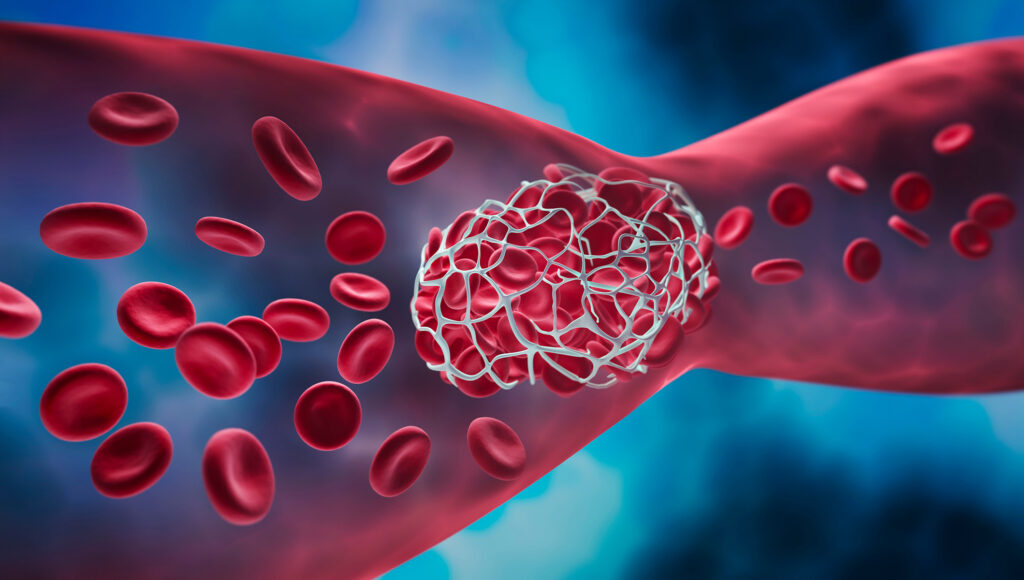Increasing Use of Pharmacologic Clot Prevention Among Adolescents with Sickle Cell Disease
Increasing Use of Pharmacologic Clot Prevention Among Adolescents with Sickle Cell Disease https://pediatricsnationwide.org/wp-content/uploads/2023/10/AdobeStock_446278183-clot-1024x580.jpg 1024 580 Mary Bates, PhD Mary Bates, PhD https://secure.gravatar.com/avatar/c6233ca2b7754ab7c4c820e14eb518c8?s=96&d=mm&r=g- October 09, 2023
- Mary Bates, PhD

Growing interest in preventing thrombosis and approval of direct oral anticoagulants may be driving a shift to pharmacologic thromboprophylaxis.
In a new study, researchers from Nationwide Children’s Hospital assessed the use of thromboprophylaxis in adolescent patients with sickle cell disease over the last decade.
Sickle cell disease (SCD) increases the risk of venous thromboembolism (VTE). However, there is limited evidence available to guide thromboprophylaxis practices in children and adolescents with SCD.
The US Food and Drug Administration recently approved the use of direct oral anticoagulants (DOACs) in pediatric patients. Prior to this, the most commonly used medication for thromboprophylaxis was available only through subcutaneous injection.
Given the increasing awareness of VTE as a preventable harm during hospitalization, and the growing use of DOACs among adolescents, researchers from Nationwide Children’s investigated the use of thromboprophylaxis over time. Using data from the Pediatric Health Information System (PHIS), they looked at more than 7,000 adolescent patients with SCD admitted to a PHIS hospital between January 2010 and June 2021.
The use of pharmacologic thromboprophylaxis increased over that time, from 1% of admissions in 2010 to 14% of admissions in 2021.
Part of this growth is due to the increased awareness of inpatient thrombosis as an issue in pediatrics, says the study’s lead author, Sarah O’Brien, MD, a pediatric hematologist and investigator in the Center for Health Equity and Outcomes Research at the Abigail Wexner Research Institute at Nationwide Children’s.
“I also think that these newly available oral medications are driving this change,” she says. “When reviewing the PHIS data, we saw use of DOACs begining 2018, and by the time we got to 2021, 25% of adolescents receiving inpatient pharmacologic thromboprophylaxis were receiving a DOAC.”
Dr. O’Brien says she has seen the impact of the approval of DOACs in clinical practice at Nationwide Children’s, where pharmacologic thromboprophylaxis is recommended for hospitalized SCD patients aged 13 years and older and most receive DOACs.
“When I round on the floor these days, the patients are taking those medications,” she says. “It’s very different than a few years ago, when they were being recommended a subcutaneous injection for thromboprophylaxis and understandably, many were declining.”
Dr. O’Brien, who is also an associate professor of pediatrics at The Ohio State University College of Medicine, says the study also highlights the variability in thromboprophylaxis in pediatric hospitals. Among the 48 hospitals included in the study, the percentage of hospitalized adolescents with SCD who received thromboprophylaxis ranged from 0% to as high as 62%. Even in hospitals where thromboprophylaxis was more frequently prescribed, the type of prophylaxis varied between institutions.
“We need national evidence-based guidelines, so that care is more standardized across institutions,” says Dr. O’Brien. “Ideally, a patient with SCD should walk into any children’s hospital and receive the same type of care in terms of clot prevention.”
Reference:
Davila J, Stanek J, O’Brien SH. Venous thromboembolism prophylaxis in sickle cell disease: a multicenter cohort study of adolescent inpatients. Blood Adv. 2023 May 9;7(9):1762-1768. doi: 10.1182/bloodadvances.2022007802.
Image credit: Adobe Stock
About the author
Mary a freelance science writer and blogger based in Boston. Her favorite topics include biology, psychology, neuroscience, ecology, and animal behavior. She has a BA in Biology-Psychology with a minor in English from Skidmore College in Saratoga Springs, NY, and a PhD from Brown University, where she researched bat echolocation and bullfrog chorusing.
-
Mary Bates, PhDhttps://pediatricsnationwide.org/author/mary-bates-phd/December 27, 2016
-
Mary Bates, PhDhttps://pediatricsnationwide.org/author/mary-bates-phd/
-
Mary Bates, PhDhttps://pediatricsnationwide.org/author/mary-bates-phd/
-
Mary Bates, PhDhttps://pediatricsnationwide.org/author/mary-bates-phd/
- Posted In:
- Uncategorized






